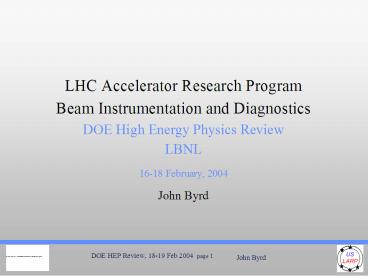LHC Accelerator Research Program PowerPoint PPT Presentation
1 / 22
Title: LHC Accelerator Research Program
1
- LHC Accelerator Research Program
- Beam Instrumentation and Diagnostics
- DOE High Energy Physics Review
- LBNL
- 16-18 February, 2004
- John Byrd
2
LARP Instrumentation Group
- BNL
- Peter Cameron
- Angelika Drees
- FNAL
- Cheng-Yang Tan
- John Marriner
- LBNL
- John Byrd
- Bill Turner
- Peter Denes
- Massimo Placidi
- Alex Ratti
- Stefano De Santis
- Jean-Francois Beche
- Jim Greer
- Max Zolotorev
- CERN
- Hermann Schmickler
- Enrico Bravin
- Steve Hutchins
- Alan Burns
- Rhodri Jones
- Fritz Caspers
- Jean-Pierre Koutchouk
- Frederick Bordry
- University of Pavia
- Franco Manfredi
- Gianluca Traversi
- Lodovico Ratti
- Massimo Manghisoni
3
LARP Beam Instrumentation and Diagnostic
Techniques
- LARP will help the LHC in 3 key areas
- Bring LHC to full energy
- Betatron tune, coupling, and chromaticity
control during ramp - Bring LHC to design luminosity
- Real-time luminosity monitor
- LHC machine protection
- Longitudinal density monitors
These contributions advance the state-of-the-art
in beam instru-mentation and have direct
contributions to present and future US
accelerator projects.
4
High Bandwidth Luminosity Monitor
- Instrument US-built TAN absorbers to measure and
optimize the luminosity of colliding bunch pairs
with 25 nsec separation
- Luminosity ? NMIP from n shower
- Crossing Angle ? ?L?R
5
LHC Luminosity Monitor
- The challenge
- High radiation environment (100 MGy/year)
- Bunch-by-bunch capability (25 nsec separation)
- The solution
- Segmented, multi-gap, pressurized ArN2 gas
ionization chamber constructed of rad hard
materials
9 cm
94 mm
6
Lumi Engineering Design
7
Chamber built
- High pressure vesselSix-layer chamber with
ceramic insulationRad-hard signal and HV cables
8
Luminometer details
- Segmented, multi-gap, pressurized gas ionization
chamber constructed of rad hard materials - 3-11 atmospheres Ar 2-6N2 gas mixture, e-
drift velocity 3.2 cm/ms - Low noise bi-polar transistor pre-amplifier
cold cable termination, ENCd 1,824 e- - Pulse shaper, t 2.5 ns
- 3 m radiation hard cable between ionization
chamber and front end electronics, radiation dose
to electronics - S/N 5 for single pp interaction
9
Instrumented TAN absorber
Instrument a Copper Bar
IP
10
Luminometer Beam Tests
- Use beam test facilities at the ALS to provide
MIPs for the detector to test - position sensitivity
- time response and gain
- accuracy
- operating experience over long time periods
- Booster-To-Storage Ring spur
- 1.5 GeV e- at 1 Hz rate
- 30 psec pulse length
- intensity from 1 to 1e9 e- (1e3 typical)
- daily access and availability
- Storage Ring spill
- 1.5 GeV e- with variable spacing
- 30 psec pulse length
- intensity of a few e-
- weekly access
11
Position Sensitivity
- Raster scan detector through pencil beam
- Record 4 quadrants
- x(left-right)/sum
- y(top-bottom)/sum
- Ionization chamber works as a true 4-quadrant
detector - x and y are independent (no crosstalk)
- Position resolution
y independent of x
x independent of y
12
Detector response time
- Measure pulse response for varying pressure, gas
mixture, and voltage. Derive drift velocity from
fit using electronics response.
Pulses a bit longer than expected due to
additional capacitance of detector/cable but
still suitable for 25 nsec operation.
13
Simulate LHC Conditions in the ALS
scraper
vacuum chamber
lost electron
electron bunches
primary EM shower
ionization chamber
Fill pattern adjustable with 2 nsec spacing into
328 buckets For example 24 nsec-41.7 MHz, max
27 bunches 26 nsec-38.5 MHz, max 25 bunches LHC
conditions 25 nsec- 40 MHz
removeable lead
14
Fast Pulse Beam Test Results
52 nsec, 11 bunches
Spilled ALS beam provides a test of LHC
conditions.
26 nsec, 22 bunches
Gap
Further studies to determine if pulses can be
deconvolved to 1 accuracy.
Gap
15
LHC Longitudinal Charge Density
- LHC beam carries 350 MJ. Beam loss in magnets can
cause severe damage. - Machine protection issues for study include
- Debunched beam at injection
- Population in abort gap
- Ghost bunches
- Bunch core and tails
- Requirements
- 104 dynamic range
- 20 samples/bunch giving 2s??1120 psec).
Corresponds to 50 psec sampling resolution. - Do this for all buckets (h35640!). Drives
overall sampling rate.
The LDM will also be an invaluable tool for beam
dynamics studies in LHC.
16
LHC Longitudinal Charge Density Specs
- Requirements (from. C. Fischer,
LHC-BSRL-ES-0005.00 rev 2.0, 07 Jan 03)
Two instruments
17
Optical Sampling Technology
- Use mixing of synchrotron radiation with a short
laser pulse to sample the longitudinal bunch
profile
LHC beams (g7000) emit the same visible light as
electron machines
Bunch
Synchrotron Photons ?1
PMT
Non-linear crystal BBO
Laser Photons ?2
Filter(?1?2)
Proof-of-principle demonstrated on the ALS.
Developed in collaboration with femtoslicing
program.
Effort not funded by LARP in FY04. Increase to
140k in FY05
18
Abort Gap Monitor
Goal detect presence of charge in gap for abort
kicker rise time Possible solution detect synch
light with gated MCP/PMT.
Similar approach used in light sources to measure
parasite bunches.
Effort not funded by LARP in FY04. Increase to
140k in FY05.
19
Initial Abort Gap Monitor Tests
Parasitic bunch
Gate signal on
20
LARP Structure
21
LARP Funding Profile
Peak in FY07 (LHC startup)
LBNL at 162k FY04
22
Summary
- US contribution to LHC instrumentation important
for bringing LHC to full energy and maximizing
luminosity. We have made tremendous progress on
two critical items - Luminosity monitor
- prototype designed, built, and fully tested
(almost!) to meet LHC specs - allows measurement of bunch crossing pairs down
to 25 nsec in high radiation environment - Longitudinal Density Monitors
- helps LHC to safely reach full energy at full
current - laser mixing technique demonstrated
- abort gap monitor is feasible
LBL has an ideal combination of experience in
electro-optic technology, synchrotron radiation,
accelerator physics and beam diagnostics to make
unique contributions to LHC

